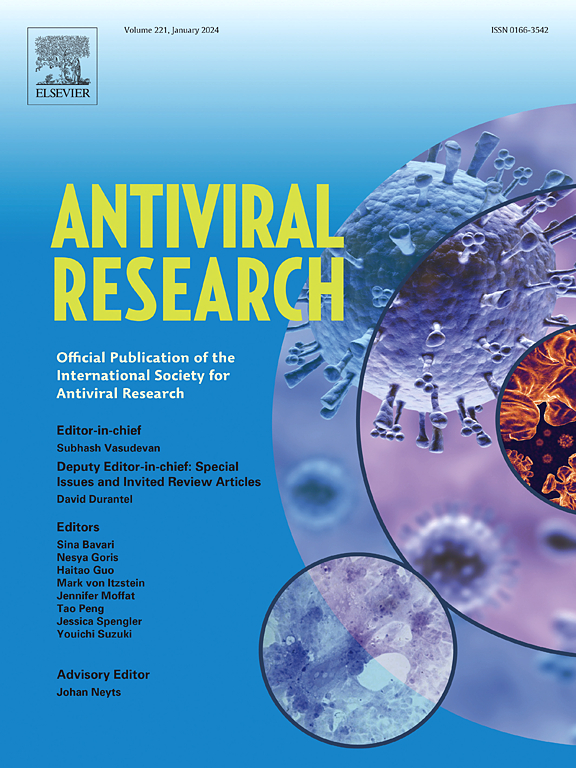M49L and other drug resistance mutations emerging in individuals after administration of ensitrelvir in Japanese clinical settings
IF 4
2区 医学
Q1 PHARMACOLOGY & PHARMACY
引用次数: 0
Abstract
Recent in-vitro and in-vivo studies and analysis of genomic information registered in GISAID have raised concerns about drug resistance mutations such as M49L after treatment with the 3C-like protease inhibitor ensitrelvir. The aim of this study was to identify resistance gene mutations to 3C-like protease inhibitors, including M49L mutations, in Japanese clinical settings. Genomic analysis of samples from our hospital admissions showed M49L mutations associated with ensitrelvir treatment in three cases and M49L mutation unrelated to ensitrelvir treatment in three cases. In a study of cases with persistent infection or rebound in viral load after 5 days of ensitrelvir treatment, 10 of 16 patients had M49L mutations and 5 had M49I mutations. Resistance gene mutations following treatment with ensitrelvir were shown to emerge even within individual patients who were not immunocompromised. In a study of persistent SARS-CoV-2 infection in severely immunocompromised patients, various drug resistance mutations emerged, with the M49L mutation especially showing a tendency to be a majority mutation. The current status of drug resistance mutations occurring in individuals following administration of ensitrelvir in Japanese clinical settings was clinically investigated for the first time. Considering that the barrier to resistance to ensitrelvir is lower than that to other antiviral drugs and that M49L is a unique mutation that occurs quickly, tends to become a majority mutation, and is maintained thereafter through its ability to replicate, the spread of strains that have acquired ensitrelvir resistance should be closely monitored.
M49L和其他耐药突变出现在个人在给药恩司替韦在日本临床设置
最近在GISAID中注册的基因组信息的体外和体内研究和分析引起了人们对使用3c样蛋白酶抑制剂ensitrelvir治疗后耐药突变(如M49L)的担忧。本研究的目的是在日本临床环境中确定对3c样蛋白酶抑制剂的耐药基因突变,包括M49L突变。我们入院样本的基因组分析显示,3例M49L突变与恩司替韦治疗相关,3例M49L突变与恩司替韦治疗无关。在一项针对持续感染或在接受ensitrelvir治疗5天后病毒载量反弹病例的研究中,16例患者中有10例发生M49L突变,5例发生M49I突变。用恩司替韦治疗后出现耐药基因突变,甚至出现在没有免疫功能低下的个别患者中。在一项对严重免疫功能低下患者持续感染SARS-CoV-2的研究中,出现了多种耐药突变,其中M49L突变尤其显示出成为多数突变的趋势。本研究首次对日本临床环境中使用恩西瑞韦后个体耐药突变的现状进行了临床调查。考虑到对恩西瑞韦的耐药屏障低于其他抗病毒药物,并且M49L是一种独特的突变,发生迅速,容易成为多数突变,并通过其复制能力维持,因此应密切监测获得恩西瑞韦耐药的菌株的传播。
本文章由计算机程序翻译,如有差异,请以英文原文为准。
求助全文
约1分钟内获得全文
求助全文
来源期刊

Antiviral research
医学-病毒学
CiteScore
17.10
自引率
3.90%
发文量
157
审稿时长
34 days
期刊介绍:
Antiviral Research is a journal that focuses on various aspects of controlling viral infections in both humans and animals. It is a platform for publishing research reports, short communications, review articles, and commentaries. The journal covers a wide range of topics including antiviral drugs, antibodies, and host-response modifiers. These topics encompass their synthesis, in vitro and in vivo testing, as well as mechanisms of action. Additionally, the journal also publishes studies on the development of new or improved vaccines against viral infections in humans. It delves into assessing the safety of drugs and vaccines, tracking the evolution of drug or vaccine-resistant viruses, and developing effective countermeasures. Another area of interest includes the identification and validation of new drug targets. The journal further explores laboratory animal models of viral diseases, investigates the pathogenesis of viral diseases, and examines the mechanisms by which viruses avoid host immune responses.
 求助内容:
求助内容: 应助结果提醒方式:
应助结果提醒方式:


